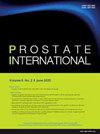前列腺癌患者血脂异常的患病率
IF 2.6
2区 医学
Q2 UROLOGY & NEPHROLOGY
引用次数: 0
摘要
研究背景:前列腺癌患者的血脂异常治疗与降低癌症进展风险和改善生存结果相关。本研究的目的是检查新诊断的前列腺癌患者血脂异常的患病率,并确定新发现的血脂异常的危险因素。方法回顾性研究2010 - 2022年间新诊断前列腺癌并接受治疗的患者血脂异常的患病率。未接受抗癌治疗(手术、放射治疗或药物雄激素剥夺治疗)的患者被排除在外。根据疾病状态(局限性与转移性前列腺癌)和药物雄激素剥夺治疗(ADT)的持续时间分析血脂异常的患病率。此外,还评估了新发现的血脂异常的危险因素。结果在1700例前列腺癌患者(1367例局限性前列腺癌,333例转移性前列腺癌)中,470例(27.6%)患有血脂异常。前列腺癌诊断时既往存在的血脂异常患病率(165例,12.1%;47例,14.1%)和治疗后新诊断的血脂异常患病率(199例,14.6%;59例,17.7%)在局限性前列腺癌组和转移性前列腺癌组之间无显著差异(P = 0.149; P = 0.311)。随着ADT持续时间的延长,新发现的血脂异常发生率明显增加(1年,14.3%;1 - 2年,16.0%;2年,24.7%;P = 0.001)。多变量分析显示,ADT持续2年以上是新发现的血脂异常的唯一独立危险因素(OR, 2.80; 95% CI, 1.72-4.53; P < 0.001)。结论:研究表明,较长的雄激素剥夺治疗时间与较高的血脂异常患病率相关。了解血脂异常与前列腺癌的关系有助于改善前列腺癌患者的管理和治疗效果。本文章由计算机程序翻译,如有差异,请以英文原文为准。
The prevalence of dyslipidemia in patients with prostate cancer
Background
The treatment of dyslipidemia in prostate cancer has been associated with a reduced risk of cancer progression and improved survival outcomes. The aim of this study was to examine the prevalence of dyslipidemia in patients newly diagnosed with prostate cancer and to identify the risk factors for newly detected dyslipidemia.
Methods
This retrospective study assessed the prevalence of dyslipidemia in patients who were newly diagnosed with prostate cancer and treated between 2010 and 2022. Patients who did not undergo anticancer treatments (surgery, radiation therapy, or medical androgen deprivation therapy) were excluded. The prevalence of dyslipidemia was analyzed according to disease status (localized vs. metastatic prostate cancer) and the duration of medical androgen deprivation therapy (ADT). Additionally, risk factors for newly detected dyslipidemia were evaluated.
Results
Out of 1,700 patients with prostate cancer (1,367 localized and 333 metastatic), 470 patients (27.6%) had dyslipidemia. The prevalence of previously existing dyslipidemia at the time of prostate cancer diagnosis (165 patients, 12.1%; 47 patients, 14.1%) and newly diagnosed dyslipidemia following treatment (199 patients, 14.6%; 59 patients, 17.7%) did not differ significantly between the localized and metastatic prostate cancer groups (P = 0.149; P = 0.311). The incidence of newly detected dyslipidemia increased significantly with the duration of ADT (<1 year, 14.3%; 1–2 years, 16.0%; >2 years, 24.7%; P = 0.001). Multivariable analysis revealed that ADT lasting more than 2 years was the only independent risk factor for newly detected dyslipidemia (OR, 2.80; 95% CI, 1.72–4.53; P < 0.001).
Conclusions
The study demonstrated that a longer duration of androgen deprivation therapy was associated with a higher prevalence of dyslipidemia. Understanding the relationship between dyslipidemia and prostate cancer may help improve the management and treatment outcomes for patients with prostate cancer.
求助全文
通过发布文献求助,成功后即可免费获取论文全文。
去求助
来源期刊

Prostate International
Medicine-Urology
CiteScore
4.40
自引率
26.70%
发文量
40
审稿时长
35 days
期刊介绍:
Prostate International (Prostate Int, PI), the official English-language journal of Asian Pacific Prostate Society (APPS), is an international peer-reviewed academic journal dedicated to basic and clinical studies on prostate cancer, benign prostatic hyperplasia, prostatitis, and ...
 求助内容:
求助内容: 应助结果提醒方式:
应助结果提醒方式:


